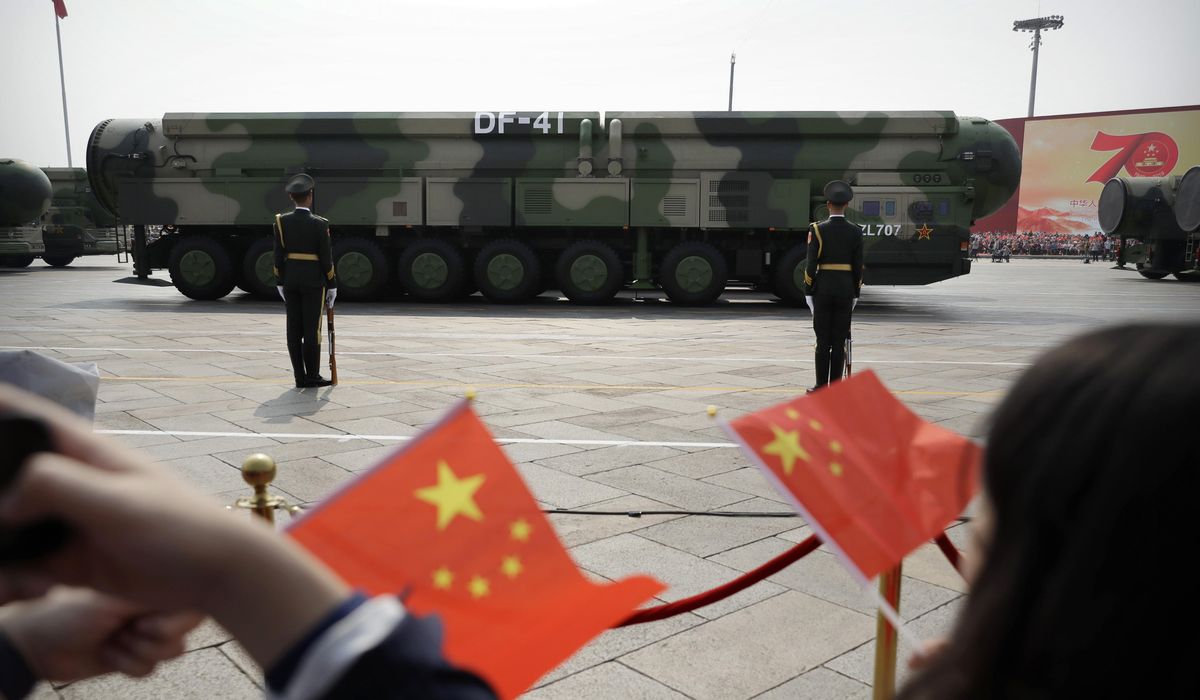China is showing no let-up in the rapid expansion of its nuclear forces and now joins Russia in posing a dual threat to American strategic deterrence of a nuclear conflict, the commander of the U.S. Strategic Command said Wednesday.
Air Force Gen. Anthony J. Cotton told reporters China continues “building out” its nuclear forces similar to the strategic breakout announced by Strategic Command in 2018, adding he remained concerned by China’s array of new strategic weaponry, including missiles, submarines and bombers.
The nuclear buildup includes a triad of mobile and land-based nuclear missiles, H-6N strategic bombers and a growing nuclear missile submarine force.
Much of the Chinese nuclear force is dual-capable — able to carry either nuclear or conventional payloads — and includes new hypersonic missiles capable of evading warning sensors and firing nuclear warheads from orbiting weapons.
“We’re not seeing any indication that they’re slowing down,” the four-star general, a former Global Strike Command commander, said during a media roundtable on the sidelines of a command-hosted conference in Omaha.
The Chinese “have a bona fide triad,” he said. “Their H-6Ns are air-refuelable; they’re practicing air refueling. Their submarine leg is the full-fledged submarine leg. And now we’re seeing what used to be just pretty limited to road mobiles [missiles] and now they have a silo-based system. So, we’re monitoring that.”
Strategic Command officials have testified to Congress that the centerpiece of the expanding nuclear arsenal is the recent construction of three large missile fields located in western China. The missile silos will house up to 320 multi-warhead missiles, including the new three-warhead DF-41 missile.
“We absolutely are observing and watching where they are,” Gen. Cotton said of the new silo-based missiles.
The command intelligence section provides regular updates on the Chinese missile fields. “We haven’t seen any pop-ups like we did originally when that was discovered,” he said of the missile launch areas.
Asked which Chinese strategic weapon system poses the greatest concern, Gen. Cotton said: “All of them.”
U.S. and Russian strategic forces have been building forces for seven decades, while China “gets to start fresh,” he said. “They get to look at best of breed [weapons] and best of breed is apparently a triad.”
A major advantage for Chinese strategic forces is that most of the systems, including missile forces, are dual-use nuclear and conventional systems. That provides military planners with a “larger portfolio” of weapons and potential uses, he said.
The Pentagon has said China rapidly expanded its warhead stockpile from around 250 warheads several years ago to its current total of around 400. Beijing is expanding the stockpile and is assessed by the Pentagon to grow to as many as 1,000 warheads by 2030, and 1,500 by 2035.
China has rejected several U.S. overtures to join nuclear arms reduction talks, despite what U.S. officials say is a requirement to do so under the 1968 Nuclear Non-Proliferation Treaty.
In May, the State Department disclosed that the number of deployed U.S. warheads is currently 1,419 warheads, along with 800 launchers for missiles, limits set by the New START arms treaty with Russia.
Gen. Cotton said in February he was required under recent legislation to notify Congress that China now has exceeded the number of U.S. strategic launchers.
Even in the face of Beijing’s expansion, the U.S. command remains capable of deterring “two near peer” nuclear competitors in China and Russia, Gen. Cotton said. Despite aging U.S. nuclear forces, the American strategic deterrent remains a credible threat and is safe, secure and effective, he said.
A multi-year, multibillion-dollar nuclear modernization is underway that will replace 400 land-based Minuteman III ICBMs with a new Sentinel missile. All 14 of the Ohio-class nuclear missile submarines will be replaced with the new Columbia-class missile submarine. And aging U.S. B-52 bombers are being replaced with the new B-21 bomber.
Gen. Cotton said he is confident that the new bombers and submarines will be built in time and has not had a briefing from the Air Force on whether the Sentinel is behind schedule or having problems with meeting the deployment schedule.
𝗖𝗿𝗲𝗱𝗶𝘁𝘀, 𝗖𝗼𝗽𝘆𝗿𝗶𝗴𝗵𝘁 & 𝗖𝗼𝘂𝗿𝘁𝗲𝘀𝘆: www.washingtontimes.com
𝗙𝗼𝗿 𝗮𝗻𝘆 𝗰𝗼𝗺𝗽𝗹𝗮𝗶𝗻𝘁𝘀 𝗿𝗲𝗴𝗮𝗿𝗱𝗶𝗻𝗴 𝗗𝗠𝗖𝗔,
𝗣𝗹𝗲𝗮𝘀𝗲 𝘀𝗲𝗻𝗱 𝘂𝘀 𝗮𝗻 𝗲𝗺𝗮𝗶𝗹 𝗮𝘁 dmca@enspirers.com



